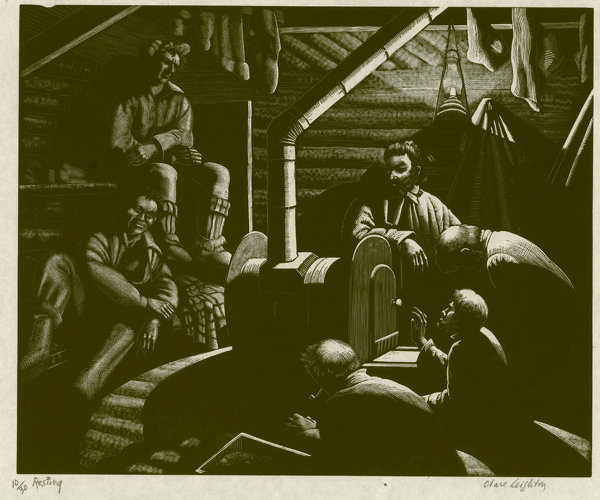about six feet. We sat inside the office and I
talked to fat, pleasant Mr Hatey and a strange,
handsome clerk called Pat. All the men's hair
needed cutting and in some cases it fell down
to their necks - nearly all French and wearing
check windbreakers. I drew the bunks and
the stove and the figures - everyone was so
amazingly good-natured. We ate with the
men in another hut, with tin mugs and tin
plates and a longer tin jug of tea. One plate
served for soup, pork, tomato sauce and
prunes and cake. There was heaps to eat and
wonderful roses on the oilcloth tablecloth.
Hatey and Mr Gray and Pat were there, and
the fat maiden who cooked. Always quantities
of strong tea. After dinner we inspected the
“dump” - thousands of logs on the lake.
I drew them until the snow got too bad.
Saw several teams of lumberjacks who had
broken camp. Pigs and a cow and many dogs.
Then went across another lake up to see them
“loading”. Drew it and photographed it. Then
back to the lake and watched them “landing”.
Then went back with Pat and Hatey and had
tea and left. Came across more frighteningly
slushy lakes. Got back - all the way in slight
snow - just at dusk. Don't forget the little fir
trees marking the road across the lake; if one
stepped on the snow part one would have
sunk.
February 18th:
Dark, grey day - snow falling. An unearthly
quiet. Went to office and then started off for
a high-up dump. We drove in the opposite
direction past woods even more beautiful
with snow. Crossed Eagle River on a little
bridge, drove about six miles, up very steep
hills that the ponies could hardly take. Passed
several “skidways” of logs on river bank.
Finally in snow I drew quick sketches of logs
etc. Back to lots of lunch.
In the afternoon walked down to lake to
watch ice being cut. Looked at dam and on
the way got up to over my knees in snow.
I realised the cruelty of snow. The men were
starting with the ice, cutting the key block.
It was almost two and a half feet deep and a
beautiful pale blue in colour, with slush on
top. Came back in their cart, standing,
keeping balanced. Snow the entire time.
I couldn't work. Came back to office and met
Mr Hatey again, then went on snow-shoes
across the fields. Tripped several times and
fell deep in the snow. Always snowing. Came
back to house and tidied and changed.
February 19th:
Wakened late - still snowing unceasingly.
Telephoned to the Eric Brains (friends) then
went for a walk alone through the bush and
drew some shapes of snow on tree stumps.
Heard voices through the trees and tracked
down on skidway and drew it as well as I
could with the snow falling upon me. Back on
the sleigh to the clearing and up to the depot,
then wandered around and drew icicles and
sleigh. After dinner drew men's sleigh
returning. Then walked out to the bush and
picked up two men who selected a large pine
and watched them cut it down. First they
axed it at the side it was to fall, then sawed it
and then, with a huge heave, it fell aslant on
to balsams etc. Mr Gray held an umbrella over
me so that I could draw it in the snow, and
placed a bed of balsam boughs for me to sit
on. I drew all stages of it. They then slashed at
the boughs and proceeded to limb it. I drew
that excitedly. Then they sawed it into logs -
up to their knees in the snow.
Then we drove to the lake where they cut ice.
Mr Gray helped while one of the men held
my umbrella. I drew them. We drove back to
the pathetic fallen tree (it had moved me
strangely to see it fall like that) and Mr Gray
made my bed and held the umbrella while I
made a study of the trunk and boughs.
We walked back to the depot and arrived
worn and tired.
Quoted in Clare Leighton, The Growth and Shaping of An Artist-Writer, p. 37-45, Published by The Estate of Clare Leighton.

